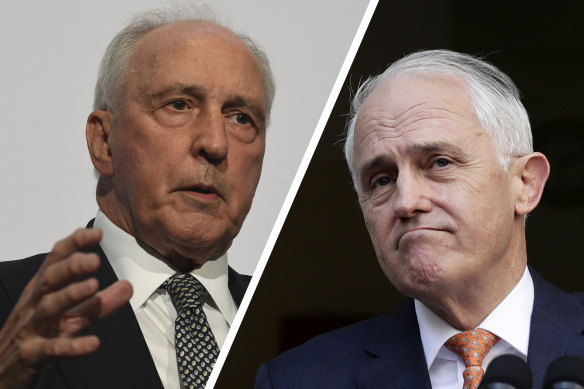Since Australia, the United States and Britain announced details of the plan for Australia to acquire a fleet of nuclear-powered submarines almost 18 months ago, the nation’s AUKUS debate has existed in two parallel universes.
In one, the three partners have been making steady progress towards turning the submarine plan into a reality, albeit with complications along the way. In the other, the project is failing catastrophically and is set to collapse in a heap at any moment.

Two former prime ministers, Paul Keating and Malcolm Turnbull, are leading the anti-AUKUS charge.Credit: Peter Braig, Alex Ellinghausen
The thing about these duelling realities is that only one of them – the first – is real. The second is conjecture, driven by a pessimistic view of the future that has morphed from understandable scepticism into overblown fatalism.
The White House this week revealed the AUKUS nations had reached a significant milestone in the signing of a new agreement to allow for the transfer of naval nuclear technology to Australia. This follows the US Congress passing landmark legislation last December authorising Australia to acquire three Virginia-class submarines from the US Navy. Australian submariners have been receiving nuclear training in the US and Britain, and US submarine visits to Australian ports are ramping up.
Despite this, the AUKUS doomsdayers continue to portray the pact as destined to collapse.
Defence expert and longtime AUKUS sceptic Hugh White argued earlier this year that the submarine plan would “almost certainly fail”, predicting that its demise was “perhaps most likely to come in Washington, where a number of hurdles could prove fatal to America’s willingness to sell us Virginia-class subs”.
Former prime minister Malcolm Turnbull – the architect of Australia’s plan to acquire conventional diesel submarines from France – is similarly gloomy.
“The reality is the Americans will not part with the Virginia-class submarines,” Turnbull told an Australia Institute event last month.
“The American legislation says that before any submarine can be sold to Australia, the US president has to certify that their navy doesn’t need it.”
Indeed, legislation passed by Congress last year requires the US president to certify that the transfer of submarines “will not degrade the United States’ undersea capabilities” and is conditional on the US “making sufficient submarine production and maintenance investments” to meet its own needs.
But these are subjective criteria inserted into the legislation to encourage the US to increase its submarine production rate in the next decade. Australia has provided more than $US3 billion ($4.5 billion) to help the US achieve that aim.
Turnbull’s view that a future US president will breezily withdraw from AUKUS, leaving one of its closest security partners with a dire undersea capability gap, overlooks the catastrophic domino effect such a decision would have for the US-Australia alliance. Australians would rightly question their close relationship with Washington, leaving the US exposed as it seeks to rally nations in the Indo-Pacific to push back on China. The US and UK have a lot to lose if AUKUS implodes, not just Australia.
As for former prime minister Paul Keating, who long ago threw nuance overboard in his AUKUS interventions, he says acquiring a handful of nuclear-powered submarines will turn Australia into the “51st state of the United States” and that AUKUS is all about American “military control of Australia”.
If so, then why, as Turnbull and White argue, would a future US president casually junk the pact?
Understandably, there has been much speculation about how AUKUS would fare under another Trump presidency. After all, Trump is an “America First” isolationist inclined to look askance at anything negotiated by Joe Biden. Predicting how such a volatile figure could act years from now is impossible. But when this masthead recently spoke to an array of experts about how Trump might approach AUKUS, the vast majority said they believed it would survive, based on the evidence at hand.
In the US, AUKUS critics from the extended MAGA universe are sniffing the breeze and softening their rhetoric. Influential commentator Eldridge Colby, in line for a senior position in a second Trump administration, previously said it would be “crazy” for the US to part with its most potent naval assets. He now says he is becoming more receptive to AUKUS as he learns more about it.
And while Trump remains a strong possibility of returning to power, the Democrats’ chances of victory have improved dramatically since Kamala Harris’ elevation to the top of the ticket. A Harris White House would undoubtedly drive AUKUS forward, maintaining continuity with the Biden administration.
AUKUS is an expensive, complicated endeavour. Big defence projects are hardly known for running on time and to budget. The final stage of the plan – manufacturing a new class of nuclear-powered submarines in Adelaide from a British design – appears especially risky. It will be important for journalists and analysts to remain clear-eyed about the enterprise’s vulnerabilities and strategic trade-offs in the years ahead. Yet when it comes to understanding such a significant project, one-sided defeatism is no more useful than mindless cheerleading.
Cut through the noise of federal politics with news, views and expert analysis. Subscribers can sign up to our weekly Inside Politics newsletter.